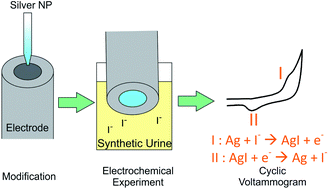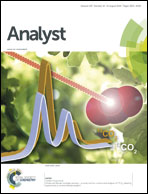Electrochemical quantification of iodide ions in synthetic urine using silver nanoparticles: a proof-of-concept
Abstract
Typical urinary iodide concentrations range from 0.3 μM to 6.0 μM. The conventional analytical method is based on the Sandell–Kolthoff reaction. It involves the toxic reagent, arsenic acid, and a waiting time of 30 minutes for the iodide ions to reduce the cerium(IV) ions. In the presented work, an alternative fast electrochemical method based on a silver nanoparticle modified electrode is proposed. Cyclic voltammetry was performed with a freshly modified electrode in presence of iodide ions and the voltammetric peaks corresponding to the oxidation of silver to silver iodide and the reverse reaction were recorded. The peak height of the reduction signal of silver iodide was used to plot a calibration line for the iodide ions. Two calibration plots for the iodide ions were obtained, one in 0.1 M sodium nitrate (a chloride-ion free environment to circumvent any interference from the other halides) and another in synthetic urine (which contains 0.2 M KCl). In both of the calibration plots, linear relationships were found between the reduction peak height and the iodide ion concentration of 0.3 μM to 6.0 μM. A slope of 1.46 × 10−2 A M−1 and a R2 value of 0.999 were obtained for the iodide detection in sodium nitrate. For the synthetic urine experiments, a slope of 3.58 × 10−3 A M−1 and a R2 value of 0.942 were measured. A robust iodide sensor with the potential to be developed into a point-of-care system has been validated.


 Please wait while we load your content...
Please wait while we load your content...